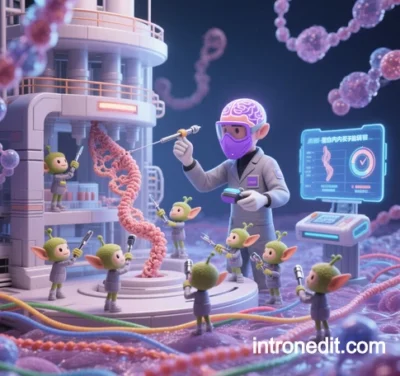
Intron editing, a critical tool in gene regulation and precision therapy, demonstrates unique technical value across biomedical fields. Below is a detailed analysis of its applications in disease treatment, genetic engineering, and interdisciplinary innovation.
I. Breakthrough Applications in Disease Treatment
- Myeloid-Specific Gene Therapy (Mucopolysaccharidosis I, MPS-I)
- Technique: Cellectis used TALEN technology to edit the first intron of the CD11b gene in hematopoietic stem and progenitor cells (HSPCs), inserting a transgene encoding α-L-iduronidase (IDUA). This design leverages myeloid-specific regulatory elements in CD11b to activate expression only during myeloid differentiation.
- Outcome: Edited myeloid cells showed a 19-fold increase in IDUA secretion without disrupting endogenous CD11b expression. In mouse models, edited HSPCs colonized bone marrow and differentiated into IDUA-carrying myeloid cells that crossed the blood-brain barrier, offering targeted therapies for metabolic and neurodegenerative diseases (e.g., Gaucher disease, Alzheimer’s).
- Congenital Retinal Disease (Leber Congenital Amaurosis)
- Technique: Synthetic RNA molecules were designed to bind aberrant splice sites in the CEP290 intron, restoring wild-type exon sequences via trans-splicing to rescue CEP290 protein function.
- Outcome: Successfully corrected photoreceptor function in mouse models, providing a novel approach for inherited eye diseases caused by nonsense mutations or large deletions.
- CTNNB1 Haploinsufficiency Syndrome
- Technique: Trans-splicing targeted the CTNNB1 intron, using antisense RNA (asRNA) to block cis-splicing signals and a CMV promoter to enhance splicing efficiency, enabling precise exon replacement.
- Significance: Offers a repair strategy for haploinsufficiency without exogenous gene insertion, minimizing genomic toxicity.
II. Innovations in Genetic Engineering and Synthetic Biology
- Microbial Engineering with Type II Introns (Targettron)
- Mechanism: Leverages the “retrohoming” property of Type II introns to insert exogenous genes (up to 2 kb) into microbial genomes. Example: Inserting cellulase genes into Clostridium thermocellum boosted biofuel production.
- Limitations: Low Mg²⁺ concentrations in eukaryotic nuclei reduce Targettron activity. Engineered ribozyme domains (e.g., RT mutants) maintain DNA damage induction in low Mg²⁺, advancing eukaryotic editing tools.
- CRISPR Vector Optimization (Plant Genome Editing)
- Technique: Intron-containing guide RNA vectors (inPTGs) embed gRNA sequences within introns to avoid transcriptional interference. Example: Achieved 30.9% knockout efficiency in rice without compromising editing rates across intron lengths (200–800 bp).
- Advantage: Resolves promoter competition in multi-gRNA co-expression, enabling complex trait engineering.
III. Interdisciplinary Frontiers
- Blood-Brain Barrier Penetration
- Case: Cellectis edited the CD11b intron in HSPCs, enabling differentiated myeloid cells to deliver therapeutic proteins (e.g., IDUA) across the blood-brain barrier. In non-human primates, 15–20% of edited cells colonized the CNS, supporting in situ treatment for Parkinson’s disease.
- Metabolic-Genetic Synergy
- Case: In myocardial infarction therapy, intron editing of metabolic genes (e.g., BCAT2) in mesenchymal stem cells (MSCs) reduced branched-chain amino acid (BCAA) accumulation, enhancing post-transplant repair efficiency.
- Quantum Computing for Splice Prediction
- Progress: Quantum annealing algorithms accelerated intron splice site prediction by 100-fold, aiding anticancer strategies targeting TP53 intron retention to improve splicing correction.
Challenges and Future Directions
- Stability Optimization: Edited HSPCs show reduced efficacy over time (40% signal loss after 6 months in mice).
- Delivery Systems: Non-viral carriers (e.g., lipid nanoparticles) require improved large DNA fragment (>5 kb) loading efficiency.
- AI-Driven Design: Reinforcement learning algorithms are under development to balance editing efficiency, specificity, and functional interference.
Conclusion
Intron editing is reshaping gene therapy through spatiotemporal precision and low genomic toxicity, with applications spanning myeloid-targeted delivery, microbial engineering, and neurodegenerative disease intervention. Future integration with AI and quantum computing promises end-to-end innovation from target discovery to clinical translation.
Data sourced from public references. For collaboration or domain inquiries, contact: chuanchuan810@gmail.com.




